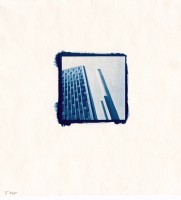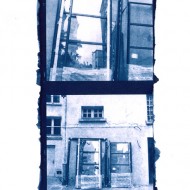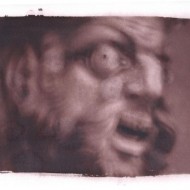Some weeks ago, talking with famous French palladium printer Jean Claude Mougin, we started discussing about cyanotype print hue. In that occasion, he said that when cyanotype tends to violet is because paper is probably basic and could contain a buffer of carbonates. As is common knowledge, cyanotypes prefer an acid environment and preserving them in a basic environment could harm their life span. Therefore, it should be better to avoid basic paper.
I tested several cyanotype papers and cheap drawing papers are my favorite; the nice watercolor paper, neutral and 100% cotton, gave inferior visual results. In particular, drawing papers have a violet tone that I found more agreeable than the cyan of the more noble ones.
Therefore I suppose those papers contain a buffer of carbonates and this could harm the life span of prints.
The development I use is more acid though, so I hope this can neutralize the paper buffer.
Dick Arentz, in his book about platinum print, another technique adapted to acid environment, explains that on modern papers, which almost all contains carbonates buffer, a double coating of sensitizer highly augment the tirage quality. Dick Arentz speculates on the fact that the first coating could be necessary to neutralize the carbonates on paper and prepare a correct environment to receive the second coating. On the other hand, pre-acidification baths practice is well known to every platinum and palladium printers, a coating of acid solution such as the palladium sensitizer equals to a mild pre-acidification, so the theory seems to make sense. In every case, if a first coating of product does help to neutralize the buffer, 10 minute of washing in an acid bath should be more than sufficient to guarantee a not excessively alkaline environment.
Moreover the majority of my cyanotypes are toned to tea with a final alkaline bath. In Mike Ware’s cyanotype book “ferric gallate” and “ferric tannate” are two stable compounds. And they are the compounds contained inside inks used for 2000 years; medieval books are written with the same product contained in cyanotype toning. This is exact only when tannic acid and sodium carbonate are mixed, and not through more complex chemistries such as a cyanotype on a paper with a buffer toned to tea. Anyway I think that the presence of an alkaline buffer doesn’t modify the product present in the print, therefore the preservation of my prints should be relatively long.
Unfortunately, the practice to add a buffer inside paper is recent, so I don’t think there’s a right and satisfying answer to cyanotype storage on modern papers. Cyanotypes I prepared some months ago didn’t move, maybe in ten years I’ll be more serene, nevertheless I’m optimistic.
Cyanotype is known to be stable as platinum or pigment prints, so I don’t think it is terribly sensitive. Tone in presence of buffer should ameliorate the stability compared to a normal cyanotype. Moreover, I’m not extremely interested into conservation problem; if my prints surpass 50 years, I’m satisfied. If it’s 100 or 500 years, well it doesn’t matter to me. I’m interested into reaching the soul of my contemporaries, during my life, what happens next I don’t care. It would be a problem if in 5 months all the prints would turn into green, as with inkjet prints of some years ago. But when a procedure guarantees some decades of life, well I’m completely satisfied.
So I will keep on printing cyanotypes on papers that have a violet tone, so sweet compared to the saturated and brilliant obtained on more neutral papers.




































You can also subscribe to this post comments RSS feed.